We’ll also dive into four specific stocks and funds to buy. They’ll hand you 6-plus percent dividends now and set you on the path to unreal payouts of 17.6-plus percent down the road.
How Powell Crushed Savers
First, if you’re disappointed in the dividend options out there today, you can blame one man: Jay Powell. (Actually, you’ll have to get in line to dump your frustrations on the poor fellow’s head.)
We all know that Powell’s clumsy “pivot” from rate hikes to rate cuts at the start of 2019 sent stocks soaring (and dividend yields plunging — as you calculate yield by dividing a company’s annual dividend payout into is current share price).
Powell’s lurch also sent the yield on the 10-year Treasury note (in orange below) crashing.
Traditional Income Plays Shrivel
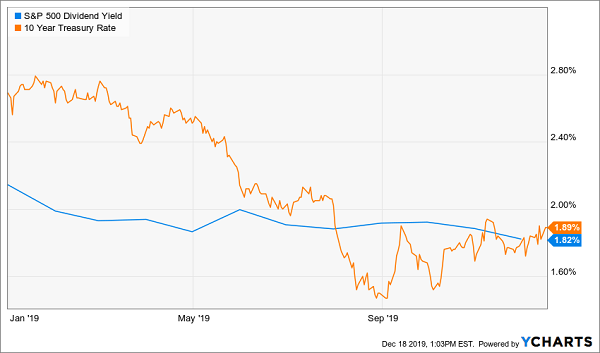
Buying either of these two options sets you up for an income stream that’s actually less than inflation this year — and of course, with stocks near all-time highs, the skimpy yields that are available are no bargains, either.
That makes what I’m going to show you now even more important. Let’s start with …
Step 1: Get Cheap 7-Plus Percent Dividends Here
First, we’re not going to let a shortage of bargains in regular stocks stop us, because there are still plenty of deals to be had in other, less-traveled corners of the market.
Like one of my favorite vehicles: closed-end funds (CEFs). They’re the cure for lousy yields.
The highest payer is throwing off a gaudy 9.2% payout — which it delivers every month, no less.
Here’s where the bargains come in: Unlike other types of funds, CEFs’ share counts are mostly fixed after their IPOs. As a result, investors can bid their shares totally out of whack with the value of the fund’s portfolio — otherwise known as its net asset value, or NAV.
The upshot? We only buy when CEFs are trading at a discount to NAV. We’ll collect our dividends while these “discount windows” slam shut, pushing our shares higher.
You can see this in action with the PIMCO Dynamic Credit and Mortgage Fund (PCI), which I recommended in Contrarian Income Report on May 6, 2016, when it traded at a 9.3% discount. Since then, PCI’s discount has flipped to an 11.4% premium.
That’s right — investors are willing to pay $1.11 for every $1 of the fund’s assets. And every time PCI’s discount has shrunk along the way, it’s pulled the market price up with it:
PCI’s Shrinking Discount Yanks Its Price Up
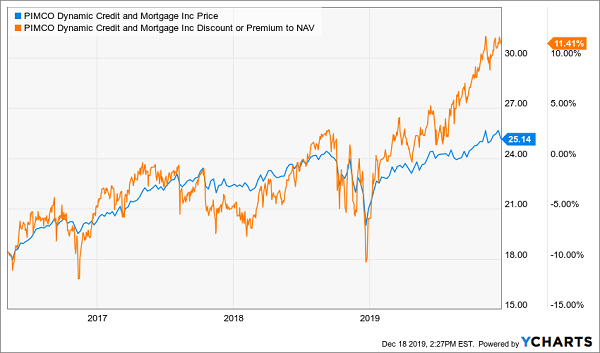
If you throw in PCI’s outsized dividend (an 8.3% yield currently, paid out every month), the 36.5% price gain shown above transforms into an incredible 102% total return — with most of that in safe dividend cash.
Dividends Boost PCI’s Return 2.8x
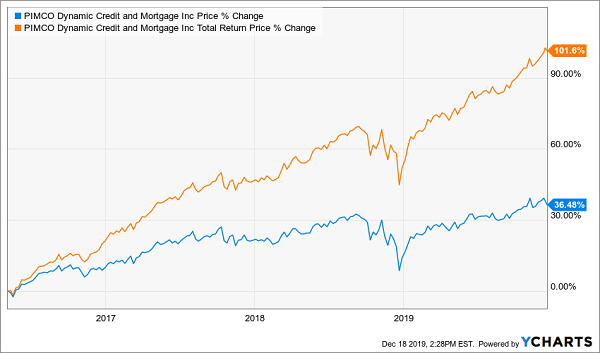
But with PCI now boasting a premium, I no longer recommend it for new money (though its 8.3% yield makes it a great fund to hang on to if you already own it).
If you’re hunting for cheap CEFs to buy now, here are three that are more than worthy of your attention. All of them tick three boxes I insist on before buying a CEF:
- A 6-plus percent dividend yield
- A discount to NAV
- 7-plus percent annualized returns on NAV over the long term.
3 More Bargain CEFs You Can Buy Now (Ranked by Discount)
| Ticker | Fund Name | Dividend Yield | Discount to NAV | Holdings | % Annualized NAV Return (10 years) |
| MGU | Macquarie Global Infrastructure Trust | 6.6% | -9.7% | Utilities and Pipelines | 9.7% |
| GDV | Gabelli Dividend & Income Fund | 6.0% | -9.4% | Large-Cap Stocks | 10.7% |
| RNP | Cohen & Steers REIT & Preferred Income Fund | 6.3% | -3.3% | REITs | 15.2% |
Now let’s move on to our next strategy for building your income stream (and the size of your nest egg) in 2020 and beyond. It’s an “automatic” dividend machine that’s even simpler than buying CEFs.
Step 2: Start “Stair-Stepping” Your Way to a Steady 17.6% Yield in 2020
In fact, there’s really only one step here: Buy dividend growers. But not just any dividend growers — if we want to pump up our yield fast, we need payouts that are accelerating.
You can see this in action with CubeSmart (CUBE), a REIT in the self-storage space — a business so boring it would make even the most conservative investor sleepy. But the company’s dividend story is anything but.
CUBE pays a 4.2% dividend. That’s more than double what the typical stock pays. But check out the incredible 1,220% payout growth CUBE delivered in the last decade:
1,220% Payout Drives a 17.6% Dividend
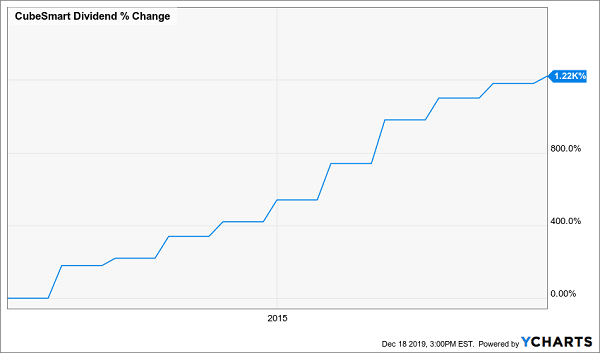
In other words, if you’d bought in late 2009, you’d be yielding 17.6% on your buy today. But as you can see above, CUBE’s payout growth is petering out, meaning it will likely take us longer than 10 years to hit a 17.6% payout if we buy CUBE now.
But I don’t think that will be the case with US Bancorp (USB). Check out how the firm’s dividend has taken off — up 71% in the last five years, with the bulk of that growth coming in just the last two years:
USB’s Dividend Takes Flight
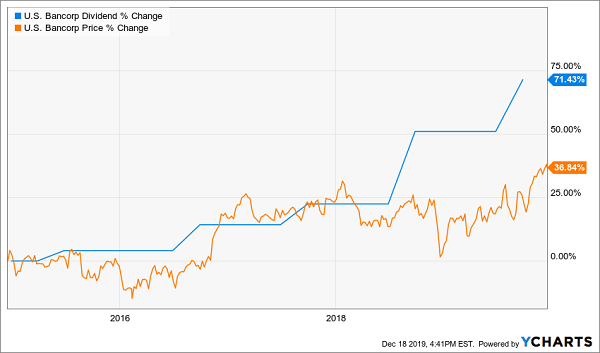
Funny thing is, investors haven’t taken notice and bid up the share price — in orange above — at the same rate as the payout has risen. (It’s common for shareholders to take a while to notice a sprouting payout; that delay is usually a great time to buy.)
In USB’s case, this lag has given us the chance to start our “automatic” dividend machine with a yield not too far off its 10-year high:
Investors Miss the Memo on USB’s Payout Growth
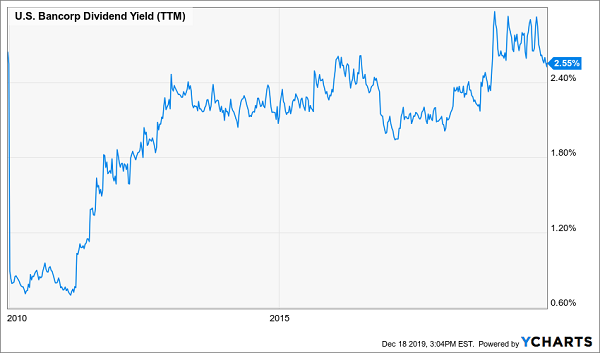
How do we know USB’s dividend will keep accelerating? For one, the bank pays out a measly 32.6% of cash flow as dividends, well below my “safety margin” of 50%. Meantime, USB is overcoming lower interest rates through loan growth, helping power earnings per share higher (up 7.2% in the third quarter).
Finally, we can grab USB at a reasonable 12.6-times free cash flow. So if you’re looking to fill out your finance holdings, this would be a good time to buy.
To learn more about generating monthly dividends as high as 8%, click here.




